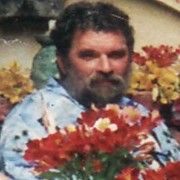Bruce Barclay
Humanitarian, entrepreneur, and one of the founders of Modern Panajachel
Bruce Barclay, founder of a worker’s paradise in Panajachel, has died. The New Yorker of Jewish heritage was 60.
After arriving in Panajachel in 1978, Barclay had a vision for the east bank of the San Francisco River, which bisects Panajachel. He purchased the upper riverside and created a magnet for impoverished Mayas seeking a better deal from life. Bruce Barclay offered them one.
These people possessed what stoneware maven Ken Edwards calls a “corporate artistic gift,” a talent shared by whole communities. The local Mayas can take an introduced artistic medium and, without training, instinctively render it in new and beautiful permutations.
Anthropologists had long been fascinated by the phenomenon. But while interest was high, capital and connections were scarce. Barclay changed all this, first by launching a ceramic cooperative to produce authentic items for export.
He profited by selling what he bought from his beneficiaries to his own small chain of storefront clothiers in the U.S. and to other retailers. He did as much as anyone to bring Guatemalan típico into the vogue it enjoyed in the United States by the 1980s. In doing so, he helped scores of families avert the bleak privation suffered by transient seasonal laborers and sharecroppers.
“He treated indigenous folks with deep respect,” says Rosa Queché Can, who as a teen began working for Barclay in 1980. “He looked out for our families in every way. He was always bettering our lives.” Barclay even paid for the construction and staffing of a free clinic, which opened not just to his workers but to their needy neighbors—some of whom would became loyal employees.
Barclay named a parcel of his land Las Manos (The Hands) to honor the artisans’ handiwork, then built houses for them on property outside of the Las Manos compound. (Eventually, the surrounding neighborhood also came to be called Las Manos.) Barclay deducted the costs for this from his workers’ wages; but, at the same time, he compensated by paying them far above the required minimum, enabling them to afford their “mortgages.” In effect, Barclay gave them homes even as he preserved their dignity.
Barclay built other cottages at Las Manos and rented them at below-market rates to starving artists, peddlers, volunteer humanitarians and anyone else needing a break. For all of these, and for his workers’ families, he added a swimming pool. He electrified the district at his own expense, buying transformers so that not only his people but others outside of Pana’s core (electrified in 1961), could enjoy modern comforts.
Over time, woodcraft, jewelry, tie-dye, stained-glass and other workshops joined the ceramic taller. Barclay also initiated Panajachel’s first-ever recycling program, and established a school, now public (see Escuela Tzalá sidebar).
In 1996, Barclay chartered the Las Manos Foundation to preserve and continue his legacy. Two years later, he moved to California, but made frequent trips to Panajachel to shepherd Las Manos’ industries. One trip followed Hurricane Stan in October 2005.
“The first thing Bruce wanted to know,” says his longtime assistant, Rufino Caníz, “was if everyone was OK [since people were killed during Stan]. He was relieved to hear that they were.” Only then did he inquire about the property. Flooding had carried off about 30% of the compound, including the pool, workshops and five houses.
“Bruce was irascible, a champion cusser, and seemingly cynical,” says one Panajachel neighbor. “But his greatest joy was in seeing others make good with the hand he extended them. That restored his faith. But he was embarrassed by people’s reactions to his generosity, so a lot of it was anonymous.”
“He had his faults,” says Californian Steve Cleaver, another friend. “But he had a big heart.”
“He was way more than just a boss,” adds Caníz, who will manage Las Manos. “He was my friend and father for years. A truly great guy.”
“If anyone deserves to be in God’s presence,” says artisan Margarita Can, “it’s Don Bruce. He did so much for my family. We are what we are because of him. We’ll see him in Eternity someday. God bless him.”
Barclay is survived by four grown children: Terra, Bella, Kenneth, Gwendolyn, and JoJo.
The Short, Happy History of Escuela Tzalá
Many do-gooders come to Guatemala, but few leave an entire school in their footprint. Bruce Barclay was one who did.
Barclay’s workers’ paradise would have been incomplete without a school, so he built one on his own property. He paid all the construction costs from his own pocket, then furnished the rooms, bought teaching materials and hired teachers.
Though Barclay built the school for his artisans’ children, he found that he could not turn away other kids whose families wanted them to attend a school that was not only in their neighborhood, but a cut above any other in town. In fact, Escuela Tzalá is today recognized as one of Guatemala’s finest public schools, thanks to a sponsor whose generosity reached legendary magnitudes.
At first, the school offered only two grades. The plan was to add one grade per year but, by 2003, it was a full K-through-six school. After Barclay had paid teachers’ salaries for five years, his assistant, Rufino Caníz, petitioned the education ministry to assume responsibility. This they did in 2003, at which time a ministry official arbitrarily renamed the school Escuela Tzalá.
The institution was moved down the street and rebuilt, but it still bears Barclay’s mark and owes its genesis to him. A movement is afoot to change its name from Escuela Tzalá to Escuela Bruce Barclay.
“I’m talking to the people from the education ministry about this,” Caníz says. “I think it will happen. It should!”

Is that your picture, Dar Lafornara? Looking good!